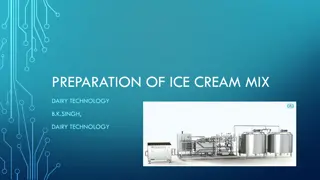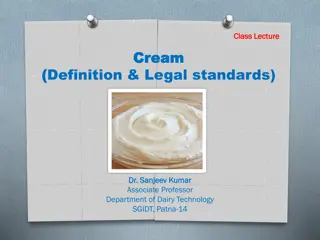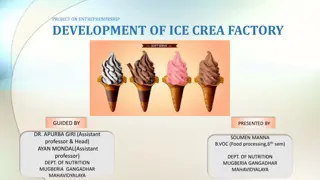Understanding the Nutritive Value and Caloric Content of Ice Cream in Dairy Technology
Ice cream, a favorite treat, offers a rich source of food energy and nutrients due to its ingredients like fat, carbohydrates, proteins, and added flavors. The caloric value of ice cream can be calculated based on the percentages of these components. Furthermore, ice cream provides vitamins, fats, proteins, and carbohydrates essential for energy production and offers various health benefits like preventing kidney stones and mood swings.
Download Presentation

Please find below an Image/Link to download the presentation.
The content on the website is provided AS IS for your information and personal use only. It may not be sold, licensed, or shared on other websites without obtaining consent from the author. Download presentation by click this link. If you encounter any issues during the download, it is possible that the publisher has removed the file from their server.
E N D
Presentation Transcript
NUTRITIVE VALUE OF ICE CREAM-CALCULATIONS AND LABELING DEPARTMENT : DAIRY TECHNOLOGY COURSE TITLE : ICE CREAM & FROZEN DESSERTS COURSE NO. : DTT -222 COURSE TEACHER: DR. BIPIN KUMAR SINGH
Energy value The energy value and nutrients of ice cream depend upon the food value of the ingredients from which it is made. Ice cream contains three or four times more fat, carbohydrate and 12-16 % more protein than does milk. In addition, it also contains other food products such as fruits, nuts, eggs, candies and sugar, which enhance its nutritive value. Ice cream is an excellent source of food energy, and fully 50% of its total solids content is sugar, including lactose, sucrose, and corn syrup solids. These constituents are almost completely assimilated and makes ice cream an especially desirable food for growing children.
Caloric Content of Ice Cream The amount of energy normally obtained from milk per gram of Carbohydrates, fats and proteins is as follows: Carbohydrates 3.87 kcal; Fat 8.79 kcal; protein 4.27 kcal. Proteins and carbohydrates are of equal energy value per gram and fats are 2.25 times as rich in energy. Minerals and vitamins do not furnish appreciable amounts of energy. The lactose content of MSNF is about 52.0% and the protein content of MSNF is about 36.0%.
Calculating Calorific Value of Ice Cream The total calorific value of ice cream depends on (1) The % of carbohydrates including lactose, added sweeteners, and sugars that may be present in fruit or flavouring. (2) The % of protein including milk protein or any other source of protein that may be present in nuts, eggs, or stabilizer and (3) The % of fat from any source including emulsifier, egg, cocoa, or nut fat that may be in the mix.
Contd.. The caloric value of100g of vanilla ice cream containing 12.5% fat, 11% MSNF, 15% sugar and 0.3% gelatin may be calculated as follows: Carbohydrates =80.19 [15+(11x 0.52)]x 3.87 Fat =109.86 [12.5x8.79] Protein =14.09 [(11x0.36)x4.27 ----------------------- 204.14kcal/100gm
Health Benefits of Ice cream Ice cream is loved by everyone. A scoop of ice cream could provide some health benefits. It contains the Vitamins such as Vitamin B12, B6, D, C and E. It is also an excellent source of fats, proteins and carbohydrates which is essential for the production of energy to the body. It also prevents the formation of kidney stones, PMS and mood swings.
Protein Content of Ice Cream The milk proteins present in ice cream are of excellent biological value, because they contain all the essential amino acids. They are important sources of tryptophan and are especially rich in lysine. They are not only known to be complete but the assimilation of ingested milk proteins is 5- 6 % more complete than for other proteins in general. Ice cream has a high concentration of MSNF, which is 34- 36 % milk protein.
Milk Fat Content This is high in food value. Fat provides the energy and mouthfeel too. It enriches and mellows the ice cream, giving it a full, rich, creamy flavor. The fat also contributes to the body and melting resistance of ice cream while producing a smoothness of texture. Milk fat consists mainly of triglycerides of fatty acids. It contains at least 60 fatty acids. It also contains non saponifiable fractions and other matter such as cholesterol, lecithin, and tocopherols.
Carbohydrates in Ice Cream Lactose, milk sugar is a disaccharide, unique, found only in milk. Liberal quantities of lactose in the ice cream produce a favorable medium in the intestinal tract for the establishment of growth of Lactobacillus acidophilus, an organism that aids carbohydrate fermentation, which in turn results in an acid condition in the intestinal contents unfavorable to protein putrefaction. Lactose favors calcium utilization. assimilation and phosphorus
Minerals in Ice Cream Ice cream is a great source of phosphorus and calcium which assist in making the teeth and bones health. It stimulates the cardiovascular health and functions of kidney. In the deficiency of phosphorus, the body won t be able to absorb calcium. It also maintains the health of joints and prevents the chances of PMS. Ice cream, which is rich in lactose, should favor assimilation of calcium, which is needed by growing children and some adults. The calcium and phosphorus content of milk and ice cream are 0.118 and 0.093; and 0.122 and 0.105 respectively in milk and ice cream.
Vitamins in Ice Cream Vitamin A:It is the principal butter fat vitamin. It is the most important in building resistance to infection in the respiratory tract, in preventing night blindness and in maintaining general good health. Vitamin B1 (Thiamine):It is essential for growth and metabolism. A deficiency in thiamine may produce symptoms of loss of appetite and weight, general weakness, degenerative changes in the nervous system and enlargement of the heart. Ice cream contains an average of 0.48 mg/kg with a range of 0.38 0.65 mg/kg. Vitamin B2 (Riboflavin) : It is a dietary essential for humans. The symptoms of riboflavin deficiency are lesions of the skin and of the eye, mouth and tongue; abnormally red lips; lesions in the corners of the mouth. Ice cream contains an average of 2.3 mg/kg with a range of 2.0 2.6 mg/kg.
Contd Vitamin B6: It has an important role in amino acid metabolism. A deficiency may produce decreased growth rate, dermatitis, anemia and convulsions. Ice cream contains an average of 0.68 mg/kg with a range of 0.27 1.15 mg/kg. Vitamin B12 (Cyanocobalamine): Vitamin B-12 is naturally found in milk, so that makes ice cream a good source.This vitamin has the most complex structure of all vitamins. It is an essential metabolite for a wide variety of organisms. A deficiency may produce pernicious anemia. Ice cream contains an average of 0.0047 mg/kg with a range of 0.0026 0.0078 mg/kg. Vitamin C (Ascorbic acid): This is the antiscorbutic factor important in the prevention of scurvy. It is not stored in the body. Ice cream contains about 10 - 11 mg/kg of Vitamin C. However, fruit ice cream is a good source of this vitamin.
Contd Vitamin D:It is the antirachitic vitamin. Its deficiency is accompanied by a decreased rate of growth and lowered calcium and inorganic phosphorus levels in the blood. These vitamin is present in trace amounts in ice cream unless milk products have been fortified with it. Vitamin E:This is known as the anti-sterility vitamin since it helps to maintain normal health and the reproductive organs. Ice cream is a fair source. It contains an average of 3 mg/kg. Vitamin K:This vitamin has been found necessary for coagulation of the blood. The concentration of vitamin K is very low in milk, and it may be destroyed during pasteurization and evaporation.
Precautions in using Ice Cream Ice cream contains fat so its excessive intake would raise the cholesterol in blood which could lead to the plaque buildup. It might increase the blood pressure. Ice cream has high amount of sugar that could lead to rise in blood sugar, weight gain and abnormal fluctuations of hormones. It should not be used by the people who are intolerant to lactose. It is rich in calcium which might cause constipation, poor appetite, kidney pain, nausea, frequent urination, excessive thirst, apathy, muscle twitches, irritability and depression.
Contd. It contains Aldehyde C-17 which is also used in plastics, dyes and rubber. It should not be consumed on an empty stomach. It lowers the carbohydrate absorption in blood stream that strains pancreas and rises the chances of pancreatic dysfunction. It may cause the infection of sinus. The presence of lactose might cause digestive problems such as bloating, flatulence etc.
Nutritional Labeling The labelling of products is essential to provide all due information and also protect to producers and consumers too. The major points to be included on label are presented below in detail: Name List of Ingredients Date of manufacture and expiry. Storage condition. Address of manufacturer Details of nutrition























